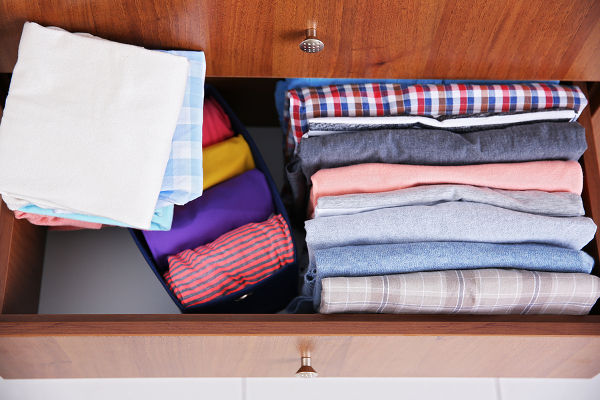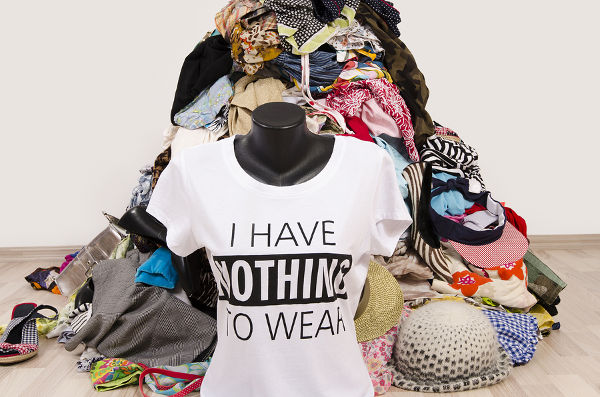You have eaten the Christmas dinner, plus lots of turkey sandwiches. You have driven hundreds of miles visiting parents, grandparents, uncles, aunts, including that slightly neurotic one who won’t let your child sit on the sofa without a protective cover. And you have helped your children unwrap and unbox what feels like 3,000 boxes of noise making plastic objects. The Christmas tree is looking sparse as its needles have fallen, but that is the only thing that is minimal about your house, as you find yourself drowning in toys, clothes, and the obligatory boxes of toiletries included in the Boots 3 for 2 gift deal.
You might be feeling grateful for the generosity of your friends and family this Christmas (whilst possibly being a little worried about the forthcoming credit card bill arising from your own generosity) but this has left you with a difficult conundrum: Where on earth are you going to put it all?
”De-cluttering” has become a popular buzzword with a whole profession developing that consists of experts who can help you de-clutter. However, for the average parent in the UK, with limited income and time, de-cluttering is simply not a priority – that is despite the positive impact it can bring to our mental health. Research has shown that too much clutter in our surroundings can affect our ability to concentrate and add additional stress to our lives.
Fortunately, there are small steps that you can take to help de-clutter that will both improve your own mental health and find room for that huge Paw Patrol Patroller Lorry that your mother thought would make a great present for your four-year old in your postage-stamp sized house. So, if you are in desperate need of space, check out these tips for a January de-clutter.
1. Don’t Aim Big

Don’t declare this Saturday to be “De-clutter Day” and plan to do everything at once. It won’t happen. Your baby will keep you awake all night before. Your toddler will fall off the dining table doing a superhero impression and you will have to spend several hours in A&E only to be told “he’s fine.” Your mother will phone and ask that you pop over to help her “move a bit of furniture” as she does her own de-clutter. In short, life will get in the way, even with the best intentions. You will likely become disheartened with the whole task, and find it more preferable to watch Gilmore Girls on Netflix instead, accomplishing very little. A different approach is required, which brings us to…
2. One Small Task a Day

Instead of seeing your clutter as one mammoth job, break it down into lots of little tasks, and aim to complete one each day. For example, one kitchen cupboard, one toy box, one shelf in your wardrobe. This is much more achievable, especially when time is so limited.
3. Schedule De-Clutter Sessions

Try and schedule in around 15 minutes to de-clutter each day. It could be during your child’s morning nap, or just after they have gone to bed but before you flake out in front of the TV. You could even create a plan of what to do each day. For example it might look like this:
- Monday: Saucepan Cupboard
- Tuesday: Under the Sink Cupboard
- Wednesday: White Toy Box in Lounge
- Thursday: Paperwork on Desk
- Friday: Top Drawer in Wardrobe
After each task, give yourself a reward, such as a soak in the bath. Just avoid the temptation to reward yourself with more stuff.
4. Divide, Conquer, and Donate

Approach each section or task with a “Divide and Conquer” mentality. Split your horde up into piles. One pile to keep, one pile to donate to charity, and one pile to throw away. This simplifies the task and makes it easier to manage.
Once you have divided your horde, it’s time to conquer it. Take out the rubbish immediately, reducing the likelihood you will pull something out to keep “just in case.” The same goes for the donate pile – drop it off at the charity shop as soon as possible. Don’t think about what you are losing – instead focus on the good you are doing through your donations. Many charity shops allow you to sign up for gift aid, and will provide you with an annual statement of house much your items have earned for the charity at the end of the year.
5. Use a Time Limit

If you haven’t used an item in a few months, then there is a good chance that you don’t need it. You can set yourself a limit on how long something can remain unused before you get rid of it. It may be six months, it may be a year. If you find it difficult to get rid of things, then try moving it to the loft, setting yourself a reminder in your calendar for another six months’ time. If you still haven’t used it by then, it’s definitely time to get rid of it.
6. De-Cluttering Toys

Some toys absolutely need to be kept, such as favourite teddy bears, etc. However, your child probably doesn’t need 10 diggers or 5 different shape sorters. Children can be very attached to their toys, so getting rid of them isn’t that easy. The best way to approach the task with younger children is to remove one or two each day that you think they no longer play with and put them into storage, out of sight for a month or two.
If your child doesn’t notice that it’s missing, then it’s very likely that the toy can then be permanently removed. With older children, you can use the process to teach them about children in developing countries and ask your child if they are willing to donate some of their toys to help. Alternatively, you could explain how if you are able to sell some of their toys second hand, you can use the money to fund a trip to a theme park you know they would want to visit.
7. Let Go of Your Keepsakes

When was the last time you looked at your wedding dress? Or at the box of cinema and theatre tickets you kept from before you and your partner had children and actually went on dates? Or at the pile of textbooks from your university degree that has had no bearing on your chosen profession? Sometimes, holding onto the past can keep us from moving forward into the future, and keepsakes, whilst precious, can hold us back from de-cluttering our home. If you haven’t looked at something in years and years, then ask yourself why you are holding onto it, and in the words of Elsa from Frozen, perhaps it’s time to “Let It Go”.
And as for that wedding dress crumpled up in a ball in an old suitcase, still with a wine stain down the front because you didn’t have the £75 to pay for dry-cleaning, please do consider donating it to charity. You can either donate it to a charity shop who will sell it on to raise money, or check out Gift of a Wedding – a UK based charity who provide weddings to terminally ill people. They will take your wedding dress and use it to help someone else’s dreams come true.
8. Create a Capsule Wardrobe

Be honest with yourself. The dress that you wore when you were 20 and a size 8 is not going to fit you anytime soon now that you have had two children and are a secret chocolate eater to negate the stress that said two children bring. And, just why do you have six pairs of jeans when you spend most of your time in pyjamas stained with snot? If your wardrobe contains enough items to stock a vintage shop then it’s time to have a clear out.
If you are feeling particularly brave, or ruthless, then you could try the capsule wardrobe approach. Coined by Susie Roux, a boutique owner in the 1970s, the idea is that your wardrobe consists of a set number of basics (usually less than 50) and that you only purchase a new item when one of those set items needs replacing. Not only will you save yourself money, but you will gain much needed space. You will also never need to worry about what to wear, as your capsule wardrobe has items for each situation.
Of course, this means letting go of the idea that you need to keep up with the latest trend, or have a different outfit each time you attend a wedding or other celebratory event. For some people, this might seem terrifying, but for others it can be truly liberating. Caroline Rector, a Texan fashion lover and reformed clothing hoarder has created a blog entitled, Unfancy, about her wardrobe capsule journey and it contains some really useful tips about how to put the idea into practice.
9. Don’t Buy Storage

It can be very easy to look at the huge pile of Lego bricks scattered across the floor on Christmas Day morning and think “I’d better check Amazon for some Lego storage boxes.” However, this doesn’t really solve the problem, it only moves it into yet more boxes of stuff. Don’t be tempted to try and organise your clutter with more Ikea storage solutions.
Instead, remember that the idea is to remove items all together, rather than simply moving them around. If you do go for the easier route of simply buying extra storage, it might look neat to start with, but you will have the same problem after the next birthday or Christmas.
10. Stop Buying Stuff

In our consumer-driven society, the pressure is on to have more and more stuff, but do we really need it and does it bring us happiness? The answer is generally no. Next time you find yourself out shopping, stop and think before you make a purchase. Do you really need it? Will it add anything to your life? Will you still be using it in six months’ time?
If you answer any of those questions with a no, then consider putting it back on the shelf. It will still be there tomorrow if you change your mind. As for those gift vouchers you got for Christmas, resist the urge to splash out in the January sales and instead save them for later in the year when you might genuinely have a need for a new item, although do bear in mind that some vouchers and gift cards have expiry dates.




